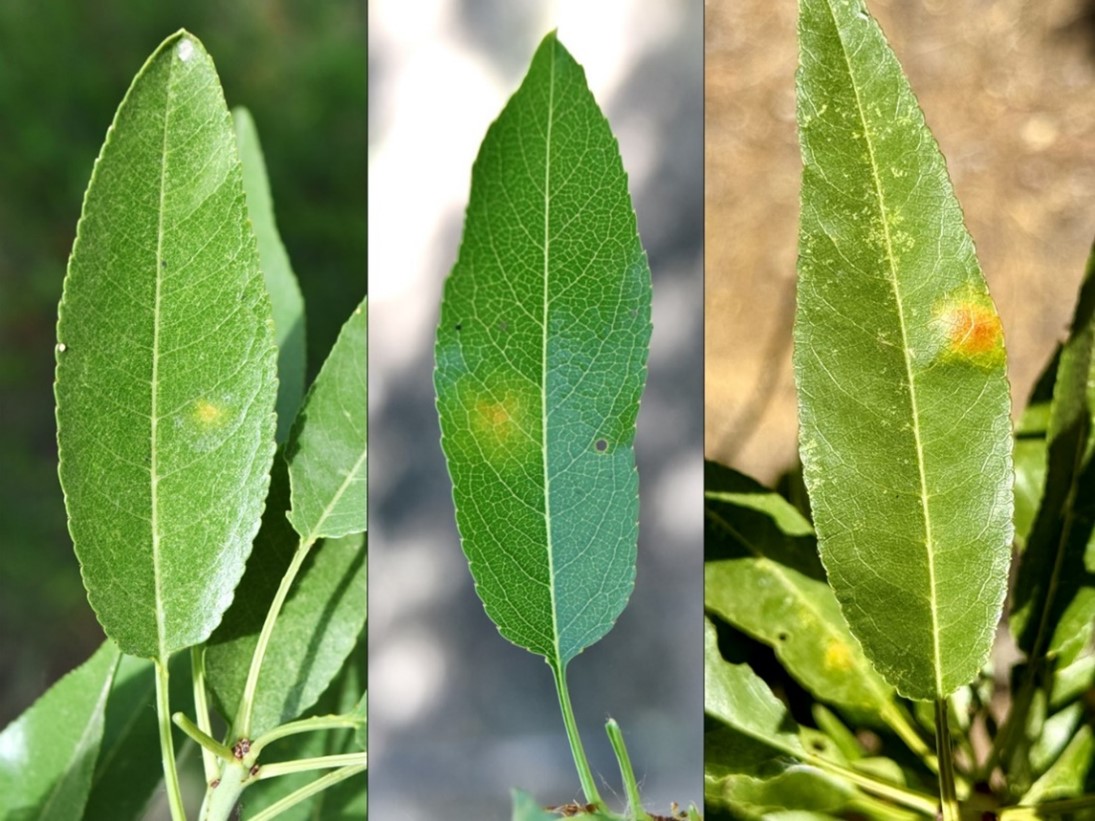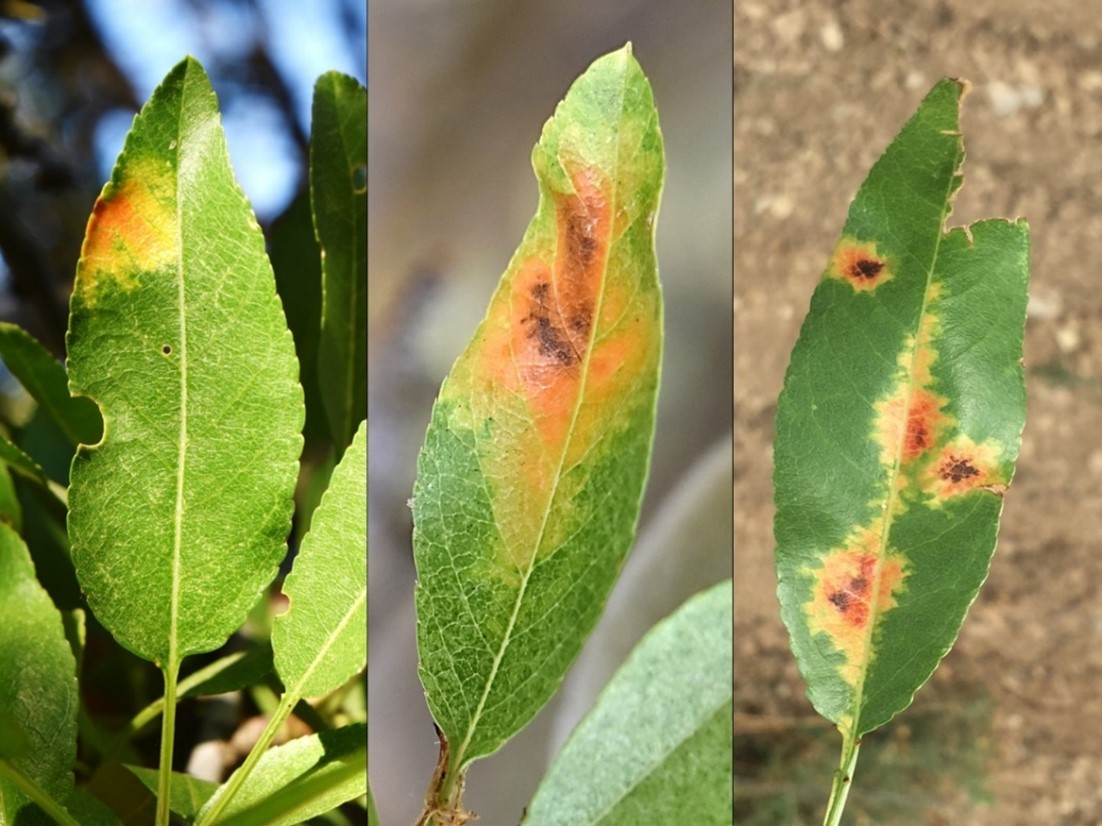Florent Trouillas, Associate Professor of Cooperative Extension, Department of Plant Pathology, University of California, Davis
Alejandro Hernandez-Rosas, Graduate student, Department of Plant Pathology, University of California, Davis
Rosa Frias, Laboratory Assistant, Department of Plant Pathology, University of California, Davis
Tawanda Maguvu, Postdoctoral Researcher, Department of Plant Pathology, University of California, Davis
Cameron Zuber, Orchard Crops Advisor, University of California Cooperative Extension, Merced and Madera Counties
Phoebe Gordon, Orchard Systems Advisor, University of California Cooperative Extension, Madera and Merced Counties
Background
Red leaf blotch (RLB), caused by the fungal pathogen Polystigma amygdalinum, is one of the most important leaf diseases currently affecting almond trees in the Mediterranean basin, particularly in Spain, and regions of the Middle East. In late May 2024, unusual symptoms on leaves, including yellow spots and orange to dark red-brown blotches, were detected in an almond orchard (Nonpareil, Monterey and Fritz) on the border of Merced and Madera counties. The disease has since been observed in Fresno, Madera, Merced, San Joaquin, and Stanislaus Counties, indicating the disease is somewhat widespread in the Northern San Joaquin Valley. Following field sampling as well as morphological and DNA/PCR analyses, our laboratory confirmed the detection of P. amygdalinum from symptomatic leaves. This is the first detection of P. amygdalinum from California almond, and the pest has formally been confirmed as being present in the state by both CDFA and the USDA. Growers and PCAs should be on the lookout for RLB as it is new to California and a serious disease of almond.
Disease symptoms and biology
Symptoms of RLB initiate as small, pale, yellowish spots or blotches that affect both sides of the leaves (Fig. 1). As the disease progresses, the blotches grow larger (1 to 2 cm) and turn yellow-orange with a reddish-brown center (Fig. 2). At advanced stages of disease development, leaves become necrotic, curl, and drop prematurely. Mainly the leaves are affected, and premature defoliation of trees can occur, thus decreasing the photosynthetic capacity of the tree during the current and following growing season, leading to a general decrease in yield.

Figure 1. Early symptoms of red leaf blotch include small, pale yellowish spots or blotches that affect both sides of the leaves. Picture credits: Alejandro Hernandez and Florent Trouillas

Figure 2. Advanced symptoms of red leaf blotch include larger, yellow-orange blotches (1 to 2 cm) that turn reddish-brown in their center. Picture credits: Alejandro Hernandez and Florent Trouillas
The disease is monocyclic, with only one primary infection cycle. The primary inoculum are ascospores that form in perithecia (sexual fruiting bodies) on fallen infected leaves from the previous growing season. Infection occurs after petal fall when young leaves emerge and spring rains occur. Rain is essential for the release and dispersal of ascospores from perithecia. The disease may not be noticed before late April to mid-May as infection remains latent for approximately 35 to 40 days. Infected leaves develop small yellow blotches that expand and become orangish to reddish-brown, with variable shapes and sizes, as the fungus colonizes more leaf tissue. During spring/summer leaves contain the pycnidia (asexual fruiting bodies) of the fungus, which produce filiform conidia. These asexual spores do not cause new infection on leaves. Infection of leaves decrease drastically after June and with high summer temperatures. Rain combined with mild temperatures in spring and early summer generally lead to higher disease incidence.
Disease Management
Research and experience in Spain where RLB is more common have shown that one preventive fungicide application at petal fall and two additional applications at two and five weeks after petal fall if rains persist are effective at controlling the disease (this exact timing is not critical but depends on the occurrence of rainfall). This means that fungicide applications and timing to control other common diseases of almond in California such as shot hole or anthracnose will likely also control this pathogen. Researchers in Spain also have shown that FRAC groups 7, 11, M3, M4 and some FRAC3 chemistries are most effective. Cultural practices, focused on eliminating the primary inoculum of infected fallen leaves, also can help mitigate the disease. These consist of removing leaf litter or applying urea to accelerate its decomposition. However, such strategies are only effective when applied over a wide area. Fungicides applied during bloom and after symptoms are visible are not effective.
If you suspect that you have this new disease in your almond orchard, please contact your local UC Cooperative Extension farm advisor


Leave a Reply